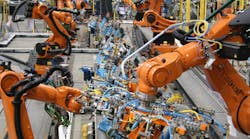Voice your opinion!
Voice your opinion!
To join the conversation, and become an exclusive member of IndustryWeek, create an account today!
Sponsored
Sponsored
“American manufacturing is on the rebound.”
Have you seen a headline like that lately?
Here’s how this feel-good story goes: America has been shedding factory jobs for years. But things got really bad in the last decade, when the slide became pronounced and we lost roughly 5.5 million manufacturing jobs between 2001 and 2010.
And then came the big turnaround: After years of American companies heading overseas to exploit foreign-based supply chains, cheap labor, and a lack of environmental regulations, the winds have shifted. Wages are rising in Asia. Energy production is booming in North Dakota and other states. And those bottom-line calculations that once sent manufacturers elsewhere now suggest bringing business back home.
And so, big companies that had shrunk their manufacturing footprints in America are opening light-bulb production lines in Ohio, computer factories in California, and phone assembly plants in Texas. They’re responding to the fact that “Made in USA”sells with their customers and doesn’t hurt with their political supporters, either: It’s what made the factory floor the most ubiquitous advertising image of the 2012 election cycle.
Now, far be it for me to argue with such calculations. But if we’re putting our trust in numbers, here’s one that needs some attention: 12,000.
That’s how many manufacturing jobs the economy has produced in 2013, despite a re-election pledge by President Obama (often repeated on the campaign trail and rarely since) to create 1 million of them during his second term. But unless we find out, when we next see the employment report, that the sector produced roughly 24,000 in September, the president will have fallen even farther behind on his goal.
But even if we assume the aforementioned narrative is true and that manufacturing is rumbling back, why aren’t the jobs coming with it?
Put simply, America still imports far more manufactured goods than it exports. Consumer demand is picking up, but our economy is not healthy yet. And despite the popular desire to bring manufacturing jobs home, many of our economic policies aren’t aligned to encourage their return. More companies than ever may be thinking about reshoring, but few have actually done so.
This problem, of course, has an answer. To paraphrase Field of Dreams: “If you build a national manufacturing strategy, the jobs will come.” And there’s plenty we can do to encourage more than the 12,000-job trickle we’ve seen to date.
We should be concerned not only with boosting America’s exports -- the measure on which the Obama administration is quick to rely -- but also with ensuring our businesses operate on a level playing field here at home, particularly against firms helped by the Chinese or Japanese governments.
We should use any potential Congressional attempt at corporate tax reform to ensure that effective tax rates for domestic manufacturing are lowered, not raised, especially in relation to industries that face no global competition.
We should continue working to expand labor talent through local, state, and federal programs. Because when the spigot of job offerings has been virtually closed for more than a decade, it takes time to bring a workforce back up to speed.
And, after the image of American manufacturing helped so many officials get elected last year, we need to hear from them that there’s dignity in working with your hands as well as your mind.
Today is MFG (manufacturing) Day, which American manufacturers and their advocates will mark by showcasing their workplaces and urging potential job seekers to take a look under the hood of industry. We at the Alliance for American Manufacturing are proud to be a sponsor of this effort.
So what better time to get serious about the productive side of our economy? Too few of our policymakers have considered the consequences that came with losing a third of our manufacturing jobs in the last decade. This economic recovery has not worked for the middle class; but a real one will occur when we begin to revalue manufacturing’s place at the heart of it.
Scott Paul is president of the Alliance for American Manufacturing (AAM)
